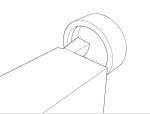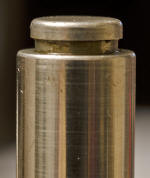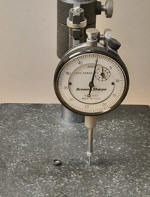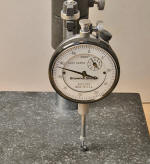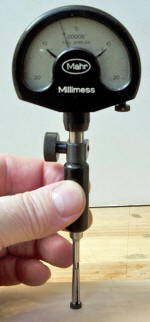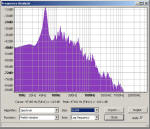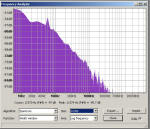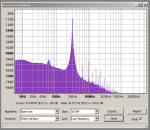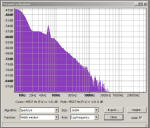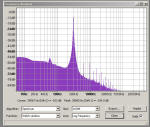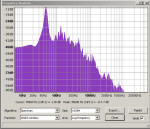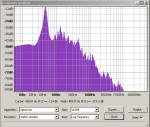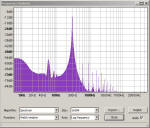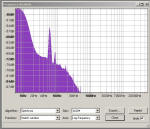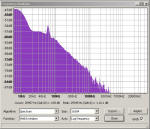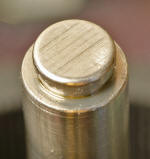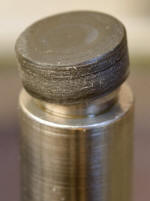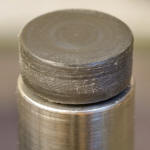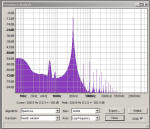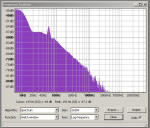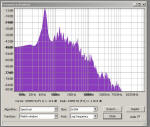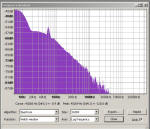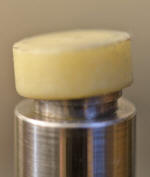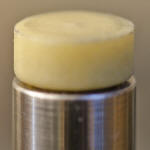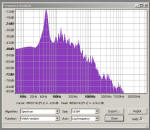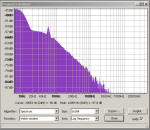-edible zone-
* 12/29/2013
note: this is a new reference. The Shelter 501-II
was replaced with a Denon DL-103R lomc cartridge. Reason: The Shelter
was producing some unwanted distortions and is now parked in its case.
Measure for Rumble and wow & flutter.
methodology: play test
record on sp10mkII using a Graham 2.2 tonearm with a Denon DL 103R (with
wood body/soundsmith ruby-LC cantilever-stylus) MC cartridge mounted.
The SP10mk2 is mounted into its "Test Mule" plinth. The plinth stands on
a Minus_K isolation platform as pictured above. Signal chain: From the
Graham, the phono cables plug into a step up transformer, then into the
Hagerman Trumpet phono stage. From the stage the signal is fed directly
into a MasterLink 9600 hard drive recorder. The Masterlink records the
test record tracks and then burns a 24-96 hi-rez CD recording. The plot
spectrums seen below were developed in Audacity.
*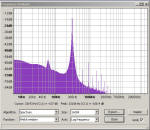 300hz tone @ +12db (HFN 001 test record)
300hz tone @ +12db (HFN 001 test record)
* Bass Drum (Shure TTR-110 test record, 3rd drum hit)
Bass Drum (Shure TTR-110 test record, 3rd drum hit)
* Silent Groove (rumble test) (HFN 001 test record)
Silent Groove (rumble test) (HFN 001 test record)
*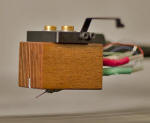 detail of the DL-103R mounted in a Uwe Panzerholz wood body.
SoundSmith Ruby cantilever / Line Contact diamond stylus.
detail of the DL-103R mounted in a Uwe Panzerholz wood body.
SoundSmith Ruby cantilever / Line Contact diamond stylus.
________________________________________________________________horizontal rule
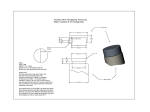 (Letter size - Thrust Pad Sketch)
(Letter size - Thrust Pad Sketch)
_____________________________________________________horizontal rule
Bearing Maintenance:
 left: oem bearing thrust pad and ball (ball shows no evidence of wear
without magnification)
left: oem bearing thrust pad and ball (ball shows no evidence of wear
without magnification)
*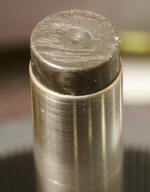 Looking at the thrust pad that is attached to the tip end of the bearing
shaft. From here it is not possible to determine how this thrust
pad is attached.
Looking at the thrust pad that is attached to the tip end of the bearing
shaft. From here it is not possible to determine how this thrust
pad is attached.
*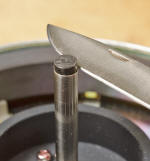 But
with some help from around the web, others indicate that the thrust pad
is really just a cap that snaps over a knob end of the shaft.
Using a pocket knife, I very gently pressed the knife edge between the
pad and shaft. Very lightly. And the cap lifted off with no
resistance.
But
with some help from around the web, others indicate that the thrust pad
is really just a cap that snaps over a knob end of the shaft.
Using a pocket knife, I very gently pressed the knife edge between the
pad and shaft. Very lightly. And the cap lifted off with no
resistance.
*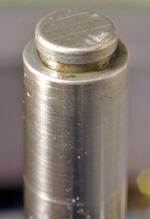 This is what I found beneath. And a little bit of gunk left over
from decades of operation.
This is what I found beneath. And a little bit of gunk left over
from decades of operation.
*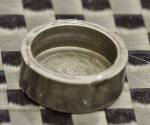 Looking within the underside of the bearing cap.
Looking within the underside of the bearing cap.
Regarding the dimple size on this oem cap it seems logical replace it with a new one. Perhaps with a more modern material.
(note: wear indicator = the size of indentation made from
contact with the bearing ball that the cap thrusts against as the
platter shaft spins)
I will look into having another wear cap
made. Perhaps I will make a small quantity and sell those at my cost to
others needing a new thrust cap.
*The first thrust cap is made. (12/30/2013)
Above: checking pad thickness (in inches) This dial indicator only reades decimal inches. It's finest graduation is .0005": slang: 5/10ths or 5 ten-thousandths.
Btw. This record player was manufactured in Japan where the metric system is used for all dimensions. Given that, and where possible, all dimensional references are in the metric system. To convert from decimal inches to millimeters simply multiply the decimal inch value by 25.4.
Above: Checking the outside diameter and then the length
Above: First ..........setting the Mahr gage. Then measuring the inside diameter of the thrust cap. Note: The Mahr gage is in inches while the setting micrometer is reporting in millimeters. Btw, the Mahr gage is very sensitive. Its finest graduation is 50 millionths of an inch. ( .00005" ) Zero on the dial is set to the nominal diameter. Deviation is indicated either positive or negative from that nominal.
Above: visual examination of the new Torlon 4301 thrust cap next to the oem nylatron cap.
The Fit:
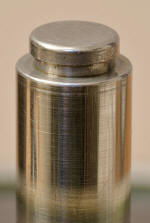

 (click thumbnail for full size image)
(click thumbnail for full size image)
**Testing**
Torlon 4301 thrust cap newly made and installed.
(click thumbnail for full size image)
Torlon 4301 one week after:
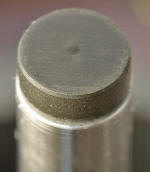 click it to see dimple full size
click it to see dimple full size
The next three plots (same tracks and order as above) are measured 1 week after installation of the 4301 thrust cap. Date 1/6/2014
___________________________________________________horizontal rule
2nd Thrust Cap: Torlon 4203 Date 1/6/2014

 (click thumbnails for full size image)
(click thumbnails for full size image)
Above two photos: Left-Yellow is Torlon 4203 ... Right-Dark is Nylatron original equipment thrust cap.
4203 Test Record plots:
measures taken right after installation: 1/06/2014
Torlon 4203 1 week after: 1/13/2014)
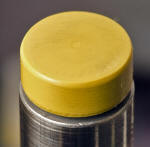 see dimple used 3 - 4 hours daily.
see dimple used 3 - 4 hours daily.
_______________________________________________________________horizontal rule
Black Delrin Thrust Cap
Above photos: Delrin cap Left, oem on the right.
Right After Installation:
See anything different? Only change = Delrin Thrust cap
Black Delrin 1 week after 1/20/2014
*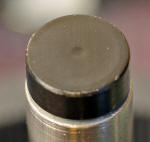 (click thumbnail to check dimple size)
(click thumbnail to check dimple size)
* silent groove side by side. Left: Delrin fresh install. Right:
Delrin 1 week
silent groove side by side. Left: Delrin fresh install. Right:
Delrin 1 week
comments: Now after 1 week it appears that the Delrin thrust
cap plots out just like the other cap materials. The dimple size on the
cap appears normal in comparison to the other materials. But the
question persists; why did the freshly installed Delrin cap plot out so
much more quietly in the first place, and then what changed in the 1
week plot.
I can say that no part of my methodology, in these
tests, has changed. The only apparent difference between the before and
after on the Delrin cap is the small evidence of wear at the thrust. At
this point I will refrain from speculating and just let the evidence
lie, while continuing with these materials tests.
________________________________________horizontal rule
*MDS Filled Nylon 1/20/2014
*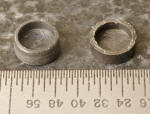
 (click thumbnail for full size image)
(click thumbnail for full size image)
Above photos: The new replacement Nylon cap on the left. Oem cap on right.
Note on machining 'this' particular nylon. The material cuts cleaner
with very, very sharp cutting edges ground with extreme rake angles. Any
further production of Nylon thrust caps will include greater attention
to producing cleaner cuts than I have done on this first sample.
MDS filled Nylon test plots 1/20/2014
Silent groove notes: appears to compare with all previous material test plots except to the fresh Delrin plot, which may be in error.
MDS filled Nylon at 1 week 1/27/2014
*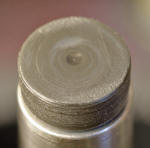 click thumbnail to check dimple full size.
click thumbnail to check dimple full size.
_____________________________________________horizontal rule
1/27/2014
Kevlar Filled Nylon
product
name: Hydlar Z
Material Manufactured by: Ensinger
Above: Left: new replacement Hydlar Z thrust cap. Right Oem
Test Record plots with the new Kevlar filled Nylon thrust cap (Hydlar Z)
After 1 week (Hydlar Z)
*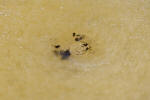 note the inclusion of unknown material. I can't say if this happened
because of the machining process, or if the inclusion was within the
material prior to the machining. Then consider that I have machined
three caps from this same stock and neither of the other two have the
inclusion.
note the inclusion of unknown material. I can't say if this happened
because of the machining process, or if the inclusion was within the
material prior to the machining. Then consider that I have machined
three caps from this same stock and neither of the other two have the
inclusion.
Test Plots 1 week out:
No difference noted. Minimal.
_____________________________________________________________________horizontal rule
* Cap Material Summary:
At this point I've tried 6 different
materials for the thrust cap job. During this trial period I have
observed some differences in the rate of wear between these materials
over the 1 week test period that has been in use for each material. The
following reports the diameter of the wear spot on each cap within this
report.
Instrument in use: a 10x Loupe with reticle manufactured
by Peak (Japan). This reticle is in decimal inches and resolves to .005
graduations.
(note: this symbol Ø is gd&t for 'diameter'.)
*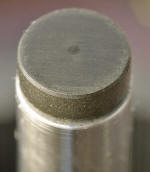 Torlon 4301 at 1 week. Wear: Ø .025 inches
Torlon 4301 at 1 week. Wear: Ø .025 inches
*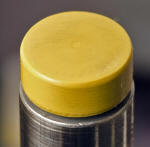 Torlon 4203 at 1 week. Wear: Ø .025 inches
Torlon 4203 at 1 week. Wear: Ø .025 inches
*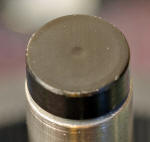 Delrin at 1 week. Wear: Ø .035 inches
Delrin at 1 week. Wear: Ø .035 inches
* MDS filled nylonat 1 week. Wear: Ø .040 inches
MDS filled nylonat 1 week. Wear: Ø .040 inches
*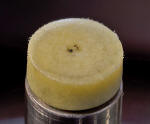 Kevlar filled nylon (Hydlar-Z) at 1 week. Wear: Ø ? imperceptible.
In different light and without magnification I can barely make out a
shiny spot but not reliably.
Kevlar filled nylon (Hydlar-Z) at 1 week. Wear: Ø ? imperceptible.
In different light and without magnification I can barely make out a
shiny spot but not reliably.
For reference:
 -- original equipment thrust cap: I think the material is nylatron but
will not bet on it. Period of use: 37 years. Wear: Ø.095 inches
-- original equipment thrust cap: I think the material is nylatron but
will not bet on it. Period of use: 37 years. Wear: Ø.095 inches
Other notes: The test record report graphs were produced before and after the 1 week period on each cap material. I saw no appreciably change between fresh and 1 week in this reporting. Except for the Delrin results which I'm tempted to toss out as an unexplained anomaly and I doubt its validity. Also it is useful to take note of the test record reporting on the original equipment 37 year old and well worn cap compared to any of these new materials.
*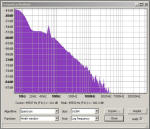 OEM cap silent groove plot: 37 years, unknown hours of use.
OEM cap silent groove plot: 37 years, unknown hours of use.
* Torlon 4203 silent groove plot: freshly installed.
Torlon 4203 silent groove plot: freshly installed.
Apart from the test record plots, listening sessions did not truly indicate any audible difference in sound quality between the above thrust cap materials. In each case sound quality was as good as I'm used to hearing from this player. Next step; the thrust bearing ball that the thrust cap spins on. Will a difference in material and quality of this bearing ball make a measurable or audible difference?
________________________________________________________________________________horizontal rule
*


